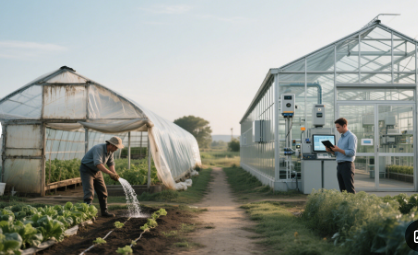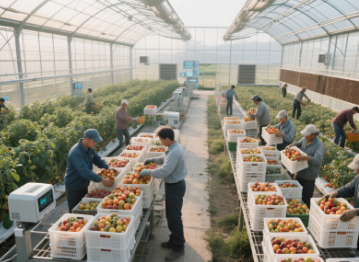Environmental Control Comparison: The Automation Advantage of Smart Greenhouses
When it comes to environmental control, smart greenhouses have a clear edge over traditional ones. Traditional greenhouses rely heavily on manual monitoring and adjustments, which can be labor-intensive and less precise. In contrast, smart greenhouses are equipped with advanced sensors and automated systems that continuously monitor and adjust temperature, humidity, light, and CO₂ levels. These systems can maintain optimal growing conditions with minimal human intervention, leading to more consistent crop growth and higher yields.
Resource Utilization Comparison: How Smart Greenhouses Save Water, Fertilizer, and Energy
Smart greenhouses are designed to maximize resource efficiency. They use precision irrigation and fertigation systems that deliver water and nutrients directly to the plant roots, reducing waste and improving uptake. This not only conserves water and fertilizer but also ensures that plants receive the exact amount of nutrients they need for optimal growth. Additionally, smart greenhouses often incorporate energy-efficient technologies such as LED grow lights, thermal screens, and energy recovery systems. These innovations can significantly reduce energy consumption compared to traditional greenhouses, leading to lower operating costs and a smaller environmental footprint.

Pest and Disease Management Comparison: The Preventative Advantage of Smart Greenhouses
Effective pest and disease management is crucial for maintaining healthy crops. Traditional greenhouses often rely on chemical pesticides and manual inspection, which can be reactive and less effective. Smart greenhouses, on the other hand, use integrated pest management (IPM) strategies combined with advanced technologies like real-time monitoring and early warning systems. These systems can detect the presence of pests and diseases early, allowing for timely and targeted interventions. By using biological controls and other sustainable methods, smart greenhouses can reduce the reliance on chemical pesticides, leading to healthier crops and a safer environment for both consumers and workers.
Initial Investment and Operating Costs Comparison: The Long-Term Benefits of Smart Greenhouses
While the initial investment for a smart greenhouse can be higher than that for a traditional greenhouse, the long-term benefits often outweigh the costs. Smart greenhouses require advanced equipment and technologies, which can be expensive upfront. However, the increased efficiency and productivity they offer can lead to significant cost savings over time. Lower water, fertilizer, and energy bills, combined with higher crop yields and better quality produce, can result in a faster return on investment. Additionally, the reduced need for manual labor can lower labor costs, further contributing to the economic viability of smart greenhouses.

Conclusion
In the battle between smart and traditional greenhouses, smart greenhouses offer numerous advantages in terms of environmental control, resource utilization, pest and disease management, and long-term cost savings. While the initial investment may be higher, the benefits of increased efficiency, sustainability, and productivity make smart greenhouses a compelling choice for modern agriculture. As technology continues to advance, the gap between smart and traditional greenhouses is likely to widen, making smart greenhouses an increasingly attractive option for growers looking to stay competitive and sustainable in the future.
Welcome to have a further discussion with us.
Phone: +86 15308222514
Email: Rita@cfgreenhouse.com
Post time: Jul-04-2025







 Click to Chat
Click to Chat